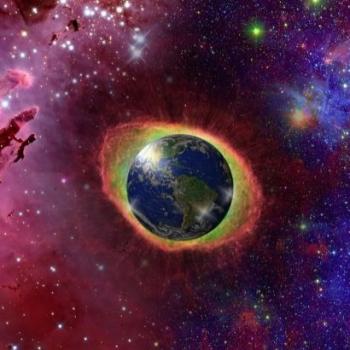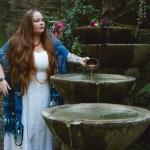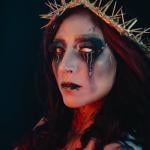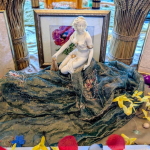One day in about 1971, Larry and Catherine, two of the founding members of our Full Moon coven, brought me a file full of papers they thought I would be very interested in. I did not look at them right away, but when I did, I was beyond interested. They had received the papers from Gavin Arthur, a very well-known astrologer and grandson of President Chester Arthur, probably by way of his friend Don Dearth. The papers told me an amazing history.
The Fellowship of the Four Jewels was founded onMay 1, 1916, by Ella Young, William Butler Yeats and his beloved Maeve (Maude Gonne), A.E., and others of the spiritual leaders of the movement for Irish freedom, in memory of those who had died in the Easter Sunday uprising only a few weeks before. The leaders had been summarily executed by the British; one of them was Major John McBride, Maude’s husband. The major’s teenage son, Sean, vowed then, I believe, to get even with the British and planned the most brilliant and humane act of revenge in history: he invented the Green Party, the European Union, and Amnesty International. It took decades, but he realized his vision. The British are obviously not saints yet, but they can no longer terrorize territories that they have occupied.
I knew some about Ella Young; I had listened to her commentaries on the radical radio station KPFA when I was in high school. Now I learned that when she came to America, she brought the Fellowship of the Four Jewels with her, and here transmuted it into the Fellowship of Shasta, with the same four feasts to represent the Four Jewels of Irish myth: the Spear of Lugh, which ensured victory (Feb. 1); the Stone of Fal, which shrieked under the lawful king (May 1); the Sword of Nuada, from which none could escape (Aug. 1); and the Cauldron of the Dagda, from which none would come away unsatisfied.
Among these papers was a testament written by Gavin Arthur on the Feast of Brighid 1970. It said:
In a night-long conversation I had with Ella Young in her cottage in Oceano where she died a few weeks later, she asked me to carry on this Fellowship. . . She and I and others celebrated all four feasts in the dunes of Oceano, 1931 through 1935 [on May 1, 1933, the Stone was Carl Beekstead, the Sword was Gavin Arthur, the Cup was Molly O’Shea, and the Spear was Hazel Dries], and off and on thereafter until she died, July 23, 1956, in Oceano. Her ashes were scattered in theLymanCanyonbehind the Old Bail Mill betweenSt. Helenaand Calistoga [in the Napa Valley of California], and there I started celebrations of the four Feasts from 1960 on. My friend Don Dearth was the most faithful of the younger generation in attendance, and to him I leave the celebration of these feasts after my death, with the injunction that he leave this charge to others.
In the fall of 1967, my beloved Sarah was taking a graduate seminar on ritual at San Francisco State from the poet and filmmaker James Broughton, and had recruited a committee from among our neighborhood friendship group to help her create a ritual for her class, based on what little we knew about Gardnerian Witchcraft. The project was going well, and one evening she told us that her class wanted to know who we were. We had called ourselves “The Bernal Heights Poets, Artists, Musicians and Fellow Travelers Chowder and Marching Society” when we went on our annual picnic at summer solstice to Angel Island State Park, but that name did not seem quite suitable.
I was doing my Master’s orals on Blake, Yeats, and Joyce, and I knew (from Marian Moore’s The Unicorn: William Butler Yeats’ Search for Reality) that Yeats has been the Grand Master of the Hermetic Order of the Golden Dawn (actually its successor, the Stella Matutina, the Order of the Morning Star—that is, Venus) and suggested that we might name ourselves after that, in homage to Yeats. Further discussion about how to replace the term “Hermetic” came up with the possibilities of “New” and “Reformed” and Orthodox”—so we adopted them all. We certainly had no clue that evening that we were creating a “Pagan occult study and dancing society” that would evolve into a new Wiccan Tradition that is still going strong 45 years later.
Gavin Arthur’s papers also included apparently unpublished essays by Maud Gonne, Red Hugh O’Donnell, and other Irish writers on the four Feasts; these were subsequently published in The Witches Trine, the NROOGD’s journal, in 1972. But what was most amazing, of course, was that after having named ourselves in honor of Yeats, we had inherited a mandate from Yeats himself to celebrate the Pagan Celtic Sabbats. That seemed like an omen that we were doing something right.
The Church of Aphrodite
One of the earliest Pagan churches in the twentieth century was The Church of Aphrodite, founded on Long Island, NY, in the 1920s by Gleb Botkin, a Russian immigrant; he later moved it to Charlottesville, VA.It was focused on the worship of Aphrodite as the Goddess of Sexuality and remained active for several decades; there were many New Yorkwriters and artists who knew about it and were sometimes active in it. I believe Theda Kenyon was one of them. She had written Witches Still Live, published in 1928, from which I had learned about the existence of a Witchcraft religion in 1955, when I was 14.
According to Chas Clifton, Botkin had argued for recognition of his church before the New York State Supreme Court in 1938 and won an official charter for the religion. The judge told him, “I guess it’s better than worshiping Mary Baker Eddy.” In a later book, he argued that Aphrodite was the supreme deity and that the creation of the universe had been like a woman giving birth. Botkin also believed that jealousy was irrational; his views seem to have been a precursor to those of Kerista. The church did not continue for very long after Botkin’s death in December 1969, but some of his followers joined Pagan movements with beliefs that drew from the Church of Aphrodite.
One member of the church in the 1940s was W. Holman Keith. In the late 1960s, Keith founded a chapter of the church in Los Angeles, calling its theology the “Neo-Dianic Faith,” which, like the NROOGD, emphasized the Divine Feminine. He was considered an elder statesman of the Pagan movement in the 1970s and contributed many articles to Green Egg, the journal of the Church of All Worlds.
For a much more detailed discussion of this early Pagan church, please see Chas Clifton’s excellent research on it in his Her Hidden Children, as well as on his blog, “Letter from Hardscrabble Creek.”












